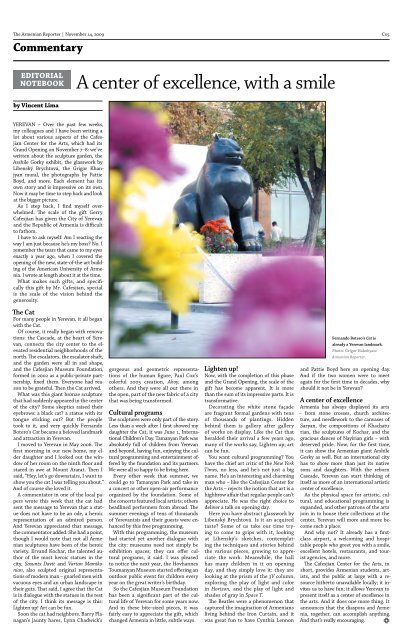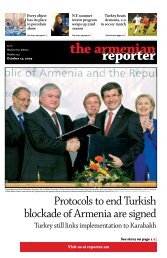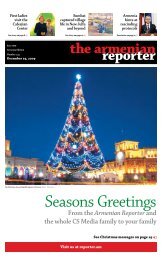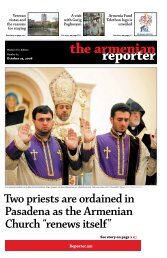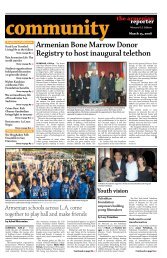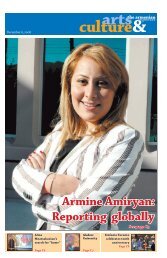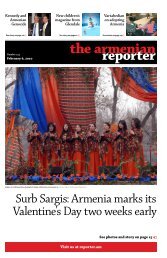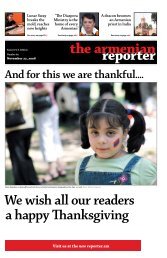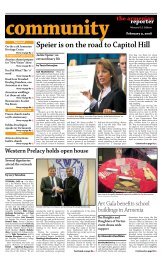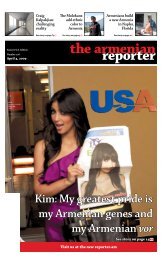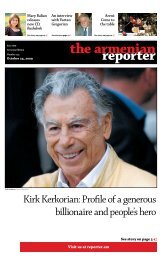Arts & Culture special pullout section - Armenian Reporter
Arts & Culture special pullout section - Armenian Reporter
Arts & Culture special pullout section - Armenian Reporter
Create successful ePaper yourself
Turn your PDF publications into a flip-book with our unique Google optimized e-Paper software.
The <strong>Armenian</strong> <strong>Reporter</strong> | November 14, 2009<br />
Commentary<br />
C15<br />
Editorial<br />
Notebook<br />
A center of excellence, with a smile<br />
by Vincent Lima<br />
YEREVAN – Over the past few weeks,<br />
my colleagues and I have been writing a<br />
lot about various aspects of the Cafesjian<br />
Center for the <strong>Arts</strong>, which had its<br />
Grand Opening on November 7–8: we’ve<br />
written about the sculpture garden, the<br />
Arshile Gorky exhibit, the glasswork by<br />
Libenský Brychtová, the Grigor Khanjyan<br />
mural, the photographs by Pattie<br />
Boyd, and more. Each element has its<br />
own story and is impressive on its own.<br />
Now it may be time to step back and look<br />
at the bigger picture.<br />
As I step back, I find myself overwhelmed.<br />
The scale of the gift Gerry<br />
Cafesjian has given the City of Yerevan<br />
and the Republic of Armenia is difficult<br />
to fathom.<br />
I have to ask myself: Am I reacting the<br />
way I am just because he’s my boss? No. I<br />
remember the tears that came to my eyes<br />
exactly a year ago, when I covered the<br />
opening of the new, state-of-the-art building<br />
of the American University of Armenia.<br />
I wrote at length about it at the time.<br />
What makes such gifts, and specifically<br />
this gift by Mr. Cafesjian, <strong>special</strong><br />
is the scale of the vision behind the<br />
generosity.<br />
The Cat<br />
For many people in Yerevan, it all began<br />
with the Cat.<br />
Of course, it really began with renovations:<br />
the Cascade, at the heart of Yerevan,<br />
connects the city center to the elevated<br />
residential neighborhoods of the<br />
north. The escalators, the escalator shaft,<br />
and the garden were all in sad shape,<br />
and the Cafesjian Museum Foundation,<br />
formed in 2002 as a public-private partnership,<br />
fixed them. Everyone had reason<br />
to be grateful. Then the Cat arrived.<br />
What was this giant bronze sculpture<br />
that had suddenly appeared in the center<br />
of the city? Some skeptics raised their<br />
eyebrows: a black cat? a statue with its<br />
tongue sticking out? But the people<br />
took to it, and very quickly Fernando<br />
Botero’s Cat became a beloved landmark<br />
and attraction in Yerevan.<br />
I moved to Yerevan in May 2006. The<br />
first morning in our new home, my elder<br />
daughter and I looked out the window<br />
of her room on the ninth floor and<br />
stared in awe at Mount Ararat. Then I<br />
said, “Hey, let’s go downstairs, I want to<br />
show you the cat I was telling you about.”<br />
And of course she loved it.<br />
A commentator in one of the local papers<br />
wrote this week that the cat had<br />
sent the message to Yerevan that a statue<br />
does not have to be an ode, a heroic<br />
representation of an admired person.<br />
And Yerevan appreciated that message,<br />
the commentator added. She had a point,<br />
though I would note that not all <strong>Armenian</strong><br />
sculptures have been of the heroic<br />
variety. Ervand Kochar, the talented author<br />
of the most heroic statues in the<br />
city, Sasunts Davit and Vartan Mamikonian,<br />
also sculpted original representations<br />
of modern man – gnarled men with<br />
vacuous eyes and an urban landscape in<br />
their guts. That said, I agree that the Cat<br />
is in dialogue with the statues in the rest<br />
of the city. I think its message is this:<br />
Lighten up! Art can be fun.<br />
Soon the cat had neighbors. Barry Flanagan’s<br />
jaunty hares, Lynn Chadwick’s<br />
gorgeous and geometric representations<br />
of the human figure, Paul Cox’s<br />
colorful 2005 creation, Ahoy, among<br />
others. And they were all out there in<br />
the open, part of the new fabric of a city<br />
that was being transformed.<br />
Cultural programs<br />
The sculptures were only part of the story.<br />
Less than a week after I first showed my<br />
daughter the Cat, it was June 1, International<br />
Children’s Day. Tamanyan Park was<br />
absolutely full of children from Yerevan<br />
and beyond, having fun, enjoying the cultural<br />
programming and entertainment offered<br />
by the foundation and its partners.<br />
We were all so happy to be living here.<br />
Every other week that summer, we<br />
could go to Tamanyan Park and take in<br />
a concert or other open-air performance<br />
organized by the foundation. Some of<br />
the concerts featured local artists; others<br />
headlined performers from abroad. The<br />
summer evenings of tens of thousands<br />
of Yerevantsis and their guests were enhanced<br />
by this free programming.<br />
With this programming, the museum<br />
had started yet another dialogue with<br />
the city: museums need not simply be<br />
exhibition spaces; they can offer cultural<br />
programs, it said. I was pleased<br />
to notice the next year, the Hovhannes<br />
Toumanyan Museum started offering an<br />
outdoor public event for children every<br />
year on the great writer’s birthday.<br />
So the Cafesjian Museum Foundation<br />
has been a significant part of the cultural<br />
life of Yerevan for some years now.<br />
And in these bite-sized pieces, it was<br />
fairly easy to appreciate the gift, which<br />
changed Armenia in little, subtle ways.<br />
Lighten up!<br />
Now, with the completion of this phase<br />
and the Grand Opening, the scale of the<br />
gift has become apparent. It is more<br />
than the sum of its impressive parts. It is<br />
transformative.<br />
Decorating the white stone façade<br />
are fragrant formal gardens with tens<br />
of thousands of plantings. Hidden<br />
behind them is gallery after gallery<br />
of works on display. Like the Cat that<br />
heralded their arrival a few years ago,<br />
many of the works say, Lighten up; art<br />
can be fun.<br />
You want cultural programming? You<br />
have the chief art critic of the New York<br />
Times, no less, and he’s not just a big<br />
name. He’s an interesting and charming<br />
man who – like the Cafesjian Center for<br />
the <strong>Arts</strong> – rejects the notion that art is a<br />
highbrow affair that regular people can’t<br />
appreciate. He was the right choice to<br />
deliver a talk on opening day.<br />
Here you have abstract glasswork by<br />
Libenský Brychtová. Is it an acquired<br />
taste? Some of us take our time trying<br />
to come to grips with it, looking<br />
at Libenský’s sketches, contemplating<br />
the techniques and stories behind<br />
the various pieces, growing to appreciate<br />
the work. Meanwhile, the hall<br />
has many children in it on opening<br />
day, and they simply love it: they are<br />
looking at the prism of the 3V column,<br />
exploring the play of light and color<br />
in Horizon, and the play of light and<br />
shades of gray in Space T.<br />
The Beatles were a phenomenon that<br />
captured the imagination of <strong>Armenian</strong>s<br />
living behind the Iron Curtain, and it<br />
was great fun to have Cynthia Lennon<br />
Fernando Botero’s Cat is<br />
already a Yerevan landmark.<br />
Photo: Grigor Hakobyan/<br />
<strong>Armenian</strong> <strong>Reporter</strong>.<br />
and Pattie Boyd here on opening day.<br />
And if the two women were to meet<br />
again for the first time in decades, why<br />
should it not be in Yerevan?<br />
A center of excellence<br />
Armenia has always displayed its arts<br />
– from stone crosses, church architecture,<br />
and needlework to the canvases of<br />
Saryan, the compositions of Khachaturian,<br />
the sculptures of Kochar, and the<br />
gracious dances of Nayirian girls – with<br />
deserved pride. Now, for the first time,<br />
it can show the <strong>Armenian</strong> giant Arshile<br />
Gorky as well. But an international city<br />
has to show more than just its native<br />
sons and daughters. With the reborn<br />
Cascade, Yerevan can start thinking of<br />
itself as more of an international artistic<br />
center of excellence.<br />
As the physical space for artistic, cultural,<br />
and educational programming is<br />
expanded, and other patrons of the arts<br />
join in to house their collections at the<br />
center, Yerevan will more and more become<br />
such a place.<br />
And why not? It already has a firstclass<br />
airport, a welcoming and hospitable<br />
people who greet you with a smile,<br />
excellent hotels, restaurants, and tourist<br />
agencies, and more.<br />
The Cafesjian Center for the <strong>Arts</strong>, in<br />
short, provides <strong>Armenian</strong> students, artists,<br />
and the public at large with a resource<br />
hitherto unavailable locally; it invites<br />
us to have fun; it allows Yerevan to<br />
present itself as a center of excellence in<br />
the arts. And it does one more thing. It<br />
announces that the diaspora and Armenia,<br />
together, can accomplish anything.<br />
And that’s really encouraging. f


